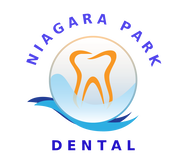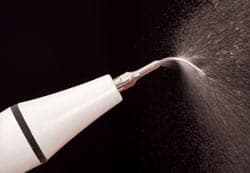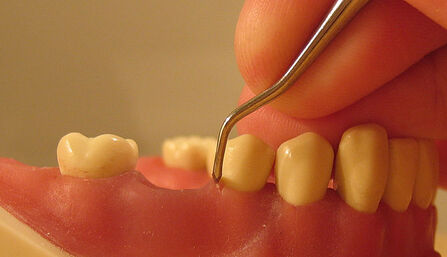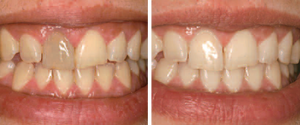|
The process of dental cleaning involves something called “scaling”. That term is used to describe the procedure of cleaning teeth with a device called Ultrasonic Scaler. As the name implies, it moves fast, very fast. The Scaler is very effective in removing the tartar (calculus) build up from your teeth. They can reach places out of reach for your tooth brush, like between the teeth or under the gum line. The calculus build up is the first step to gum problems, so scaling definitely saves your gums, and lets you enjoy happier cleaner mouth. Before the advent of these Scalers, removal of calculus was a tedious job done manually using hand instruments. The technology was introduced in the 1950s and was advocated first to clean the outer layers of the tooth, but since then, it developed and proven effective and safe to use even under the gum line. They used to be operated by a device on their own, but now all modern day dental treatment units come equiped with a Scaler. Manual scaling Scalers work by vibrating with high energy, thus crushing and removing plaque and calculus. The resulting shockwaves also tend to disrupt bacterial cell function. Water is accompanied, to flush away the dislodged calculus, and to cool the instrument preventing heat damage to teeth and gums. The advantages they offer over manual scaling: – More effective. – Reach more areas like deep pockets and under gum lines. – Faster than manual scaling, saving both the patient and dentist plenty of time. However, they are not bereft of disadvantages: – They cause tooth sensitivity, that is usually short lived and manageable. – If used over-zealoulsy, they scratch the surface of the tooth, making it more inviting to Plaque formation. – They might crack porcelain crowns. – They might damage implant surfaces. – They should be used with caution in patient with cardiac pacemakers. Conclusion:Ultrasonic Scalers are very effective and ensure you have a healthy gum, but they need to be wielded by an expert hand.
0 Comments
Eating healthy is important for healthy body. Eating healthy also affects your smile. Your dental health can be affected by what you eat, and can deteriorate with time. Here are some hints on what to eat for a healthier teeth, gums, and healthier smile. Essential Vitamins And Minerals-Calcium: There is a calcium circulation in our bodies. It is stored in bones and teeth. If you don’t get enough calcium, your body might get his requirement from these reserves, weakening your bones, causing gum disease and tooth loss. -Iron: The first symptoms of iron deficiency might manifest in the mouth. causing lip cracking, tongue inflammation, and sore mouth. so make sure to eat red meat to get the iron you need. -Vitamin A: It is important for your salivary glands to function. Saliva washes the teeth getting rid of plaque, so any deficiency in vitamin A, might mean reducing salivation, leaving your teeth exposed to plaque and germs. You can get Vitamin A via Potatoes, Melons, and Spinach. -Vitamin B: Required for the nervous system. lacking Vitamin B3 can cause bad breath and canker sores. You can get it in Fish and Chicken. -Vitamin C: Helps build up of Collagen fibers all over the body, hence it is important for healthy gums. It is also important for the immune system. Lower immune system might mean lots of decay. You can get it in citrus fruit and capsicum. -Vitamin D: Regulates calcium levels and works on your bones and teeth. Lack of vitamin D means, you are not absorbing calcium. deficiency in vitamin D can cause burning mouth syndrome, causing bad breath and metallic taste. You can get vitamin D from eggs, milk, and fish. ConclusionJust like it is important for the general health, watching your diet is important for the oral health as well.
One of the causes of tooth discoloration is receiving root canal treatment. For one reason or another a front tooth might undergo such treatment. The tooth after this becomes “dead”. meaning there is no nerve and no blood supply in the core of the tooth. If the tooth required such treatment due to trauma, sometime blood pigmentation makes the discoloration worse. What can be done? usually a traumatized toth requires a porcelain crown. However if the tooth structure was not damaged significantly. A porcelain crown might be avoided, and to restore the white color fo the tooth, we can do Internal bleaching. What does that involve? – after finishing the root canal. we end up with a space where it was occupied by the nerve, this space is called pulp chamber. we drill about 1-2mm into the root canal from the chamber. – A bleaching medicament is placed into the chamber and sealed. – following the manufacturer’s instructions, we leave this medicament within the tooth for a certain period of time. then it might be reapplied. – when the treatment is finished, the medicament is removed and a definite filling is used to close the access cavity. so in essence in this procedure, we are whitening the tooth from inside out. So it is called internal bleaching. sometimes even if the tooth is going to be restored with a porcelain crown, such procedure is advised because if the tooth is too dark, it might affect the resulting shade of the porcelain giving us an undesirable shade. How good is it? It is quite effective in bleaching a tooth, however sometimes it might be combined with an external option. The darker the tooth is, then less chance for the treatment to work by itself. But for the most common cases, it is quite effective and no more whitening is required. Conclusion:If you had a trauma and your tooth appears darker, the solution might not be as costly as you think. talk to us to see if you can have internal bleaching.
Tooth decay is the most common disease entity for adults and children alike. You need to understand the process of tooth decay to prevent it. Prevention is better than cure. Toot decay is preventable. For tooth decay to happen, you need four elements: 1- Toot structure; if you have porcelain, or dentures, they will not get decayed, but remember that there is a tooth under that porcelain that can indeed get decay. 2- Sugar material, this is what gets transformed into acid by the next element: 3- bacteria. you cannot eliminate bacteria from your mouth, they colonize our moths via food and air. they form a layer called dental plaque and use the sugar to produce acid 4- Time; the bacteria need time to digest the sugar and produce acid. then time is needed for the acid to break down your tooth. once the tooth starts to desolve under the effect of acid, it gets weaker and starts to break down forming a hole “cavity” in your tooth so prevention starts with breaking the cycle. How to work on these elements to prevent tooth decay:1- tooth structure: a- first try to make this tooth less exposed to food, so try not to snack between meals b- try to keep your tooth, plaque-free by brushing after meals and flossing. c- use Xylitol gum, this substance prevents the bacteria from adhering to your tooth structure. d- don’t miss your routine check and clean, keeping your tooth surface smooth free of calculus means less chance for germs to adhere to it. e- keep checking old fillings and crowns. if the dentist sees a rough margin of a filling, better fix it. f- make sure to clean the margins of crowns. these are rough surfaces and bacteria adhere to them easily. g- ask us to place fissure sealants on your teeth. to prevent bacteria from colonizing these fissures that are out of reach, even for your tooth brush. h- make sure to use fluoridated tooth paste, that strengthens your tooth structure, and also don’t miss your 6 monthly fluoride application. 2- Sugar material a- always go for the sugar-free option. b- avoid snacking between meals c- after each meal, brush your teeth, to get rid of residual sugar. d- Sugar-less gum. this encourages salivation, which washes your teeth. use Xylitol gum, Xylitol has also been shown to help remineralize our teeth’s enamel 3- Bacteria: a- brush at least twice a day for two minutes each time. to get rid of dental plaque b- floss once a day to remove the bacteria between teeth c- use anti-bacterial mouth wash.These oral rinses are designed to decrease cavity causing bacteria in the mouth while utilizing fluoride to strengthen enamel against breakdown. If brushing and flossing is done properly, use of an oral rinse should complete the protection against tooth decay Other preventive measures:– For snacks: best snacks for your dental health include raw vegetables, fruits, and nut. Apples are the perfect snack for dental health as they act as a tooth cleaner and whitener. They are able to clean your teeth by the abrasive action of the skin and hard inner surface of the apple, they have malic acid which helps remove surface stain and keep teeth whiter. So next time you are looking for a midday snack pick up an apple. – Fluoridated water This very important for children. However use water that has been fluoridated by the local council, as excessive fluoride can be harmful to your teeth. Conclusion:Tooth decay is preventable juts by following simple rules and keeping in mind that your teeth can suffer from what you do and what you eat. Make sure to keep your dental visits. Maybe one day, we will have a generation free of tooth decay . Until then, we need to follow the steps above to maintain good oral health.
|
AuthorArticles are written by Dr M Hajarat. Archives
July 2024
|
|
Niagara Park Dental
3 / 16 Washington Avenue Niagara Park, NSW 2250 Email: [email protected] Phone: (02) 4329 3003 |
HOURS
Mon 9:00 - 5:30 Tue 9:00 - 5:30 Wed 9:00 - 5:30 Thu 9:00 - 5:30 Fri 9:00 - 5:30 |
|










